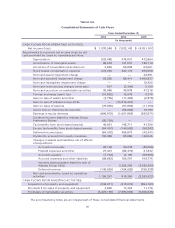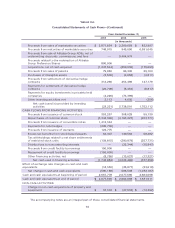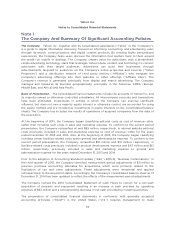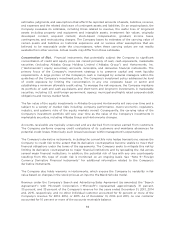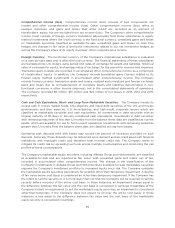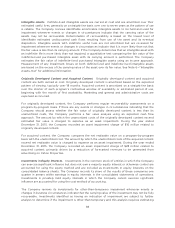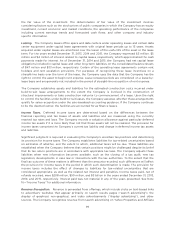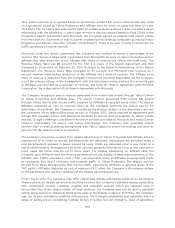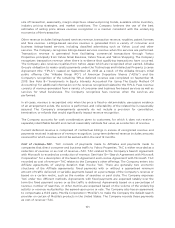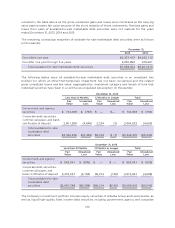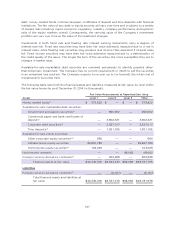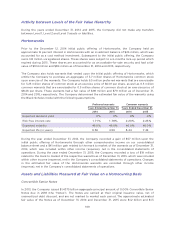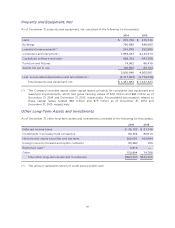Yahoo 2015 Annual Report Download - page 105
Download and view the complete annual report
Please find page 105 of the 2015 Yahoo annual report below. You can navigate through the pages in the report by either clicking on the pages listed below, or by using the keyword search tool below to find specific information within the annual report.size of transaction, seasonality, margin objectives, observed pricing trends, available online inventory,
industry pricing strategies, and market conditions. The Company believes the use of the best
estimates of selling price allows revenue recognition in a manner consistent with the underlying
economics of the transaction.
Other revenue includes listings-based services revenue, transaction revenue, royalties, patent licenses
and fees revenue. Listings-based services revenue is generated from a variety of consumer and
business listings-based services, including classified advertising such as Yahoo Local and other
services. The Company recognizes listings-based services revenue when the services are performed.
Transaction revenue is generated from facilitating commercial transactions through Yahoo
Properties, principally from Yahoo Small Business, Yahoo Travel, and Yahoo Shopping. The Company
recognizes transaction revenue when there is evidence that qualifying transactions have occurred.
The Company also receives royalties from Yahoo Japan which are recognized when earned. Alibaba
Group’s obligation to make royalty payments under the Technology and Intellectual Property License
Agreement (the “TIPLA”) ceased on September 24, 2014 as a result of the Alibaba Group’s initial
public offering (the “Alibaba Group IPO”) of American Depositary Shares (“ADSs”) and the
Company’s recognition of the remaining TIPLA deferred revenue was completed on September 18,
2015. See Note 8—“Investments In Equity Interests Accounted For Using The Equity Method Of
Accounting” for additional information on the revenue recognized related to the TIPLA. Fees revenue
consists of revenue generated from a variety of consumer and business fee-based services as well as
services for small businesses. The Company recognizes fees revenue when the services are
performed.
In all cases, revenue is recognized only when the price is fixed or determinable, persuasive evidence
of an arrangement exists, the service is performed, and collectability of the related fee is reasonably
assured. The Company’s arrangements generally do not include a provision for cancellation,
termination, or refunds that would significantly impact revenue recognition.
The Company accounts for cash consideration given to customers, for which it does not receive a
separately identifiable benefit and cannot reasonably estimate fair value, as a reduction of revenue.
Current deferred revenue is comprised of contractual billings in excess of recognized revenue and
payments received in advance of revenue recognition. Long-term deferred revenue includes amounts
received for which revenue will not be earned within the next 12 months.
Cost of revenue—TAC. TAC consists of payments made to Affiliates and payments made to
companies that direct consumer and business traffic to Yahoo Properties. TAC is either recorded as a
reduction of revenue or as cost of revenue—TAC. TAC related to the Company’s Search Agreement
with Microsoft is recorded as a reduction of revenue. See Note 19—“Search Agreement with Microsoft
Corporation” for a description of the Search Agreement and License Agreement with Microsoft. TAC
recorded as cost of revenue—TAC relates to the Company’s other offerings. The Company enters into
Affiliate agreements of varying duration that involve TAC. There are generally two economic
structures of the Affiliate agreements: fixed payments with or without a guaranteed minimum
amount of traffic delivered or variable payments based on a percentage of the Company’s revenue or
based on a certain metric, such as the number of searches or paid clicks. The Company expenses
TAC under two different methods. Agreements with fixed payments are expensed ratably over the
term the fixed payment covers or as the traffic is delivered. Agreements based on a percentage of
revenue, number of searches, or other metrics are expensed based on the volume of the underlying
activity or revenue multiplied by the agreed-upon price or rate. The Company also has an agreement
to compensate a third party, Mozilla Corporation (“Mozilla”), to make the Company the default search
provider on certain of Mozilla’s products in the United States. The Company records these payments
as cost of revenue—TAC.
101


